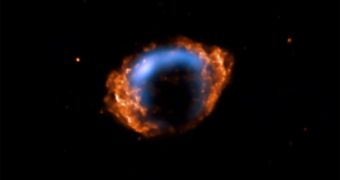The newly found supernova remnant is the result of a stellar explosion that would have been seen from Earth some 140 years ago. The previous youngest supernova remnant found in the Milky Way was Cassiopeia A, resulted some 330 years ago. The current record holder, G1.9+0.3, represents to astronomers a missing link between supernovae and supernova remnants.
According to them, the Milky Way should produce two or three supernova explosions every century or so, meaning a total of 60 supernovae over a period of 2,000 years. However, only 10 supernova remnants have ever been confirmed to be younger than 2,000, since the discovery of the Cassiopeia A supernova remnant until today.
Supernova explosions are created by stars at the end of their lives. As the star becomes unstable, it ejects most of the outer shell of material surrounding it into interstellar space. The ejection of material is accompanied by extreme radiation emissions in the electromagnetic spectrum, some high enough to outshine a whole galaxy.
Most of the times the ejected material encounters interstellar material as it travels through space, and creates a supernova remnant, a shell of hot gas and high-energy particles, shinning brightly in X-ray and radio waves. Aside from being some of the most violent events in the universe, supernova explosions help create and spread into interstellar space all of the elements heavier than iron, to create new stars, new planets and life.
G1.9+0.3 lies 25,000 light years away from Earth, in the Sagittarius constellation, meaning it is only 1,000 light years away from the galactic nuclei. This also means that the supernova explosions that occurred 140 years ago, in reality took place 25,140 years ago. It is a Type Ia supernova, thus its progenitor is a white dwarf, with an estimated mass of about 1.4 times that of the Sun.
Measurements conducted between 1985 and 2007 revealed that it expanded into space at a speed of about 56 million kilometers per hour and that the bright light emission created in the outcome of the explosion would have not been observed from Earth because of a thick cloud of interstellar gas between the Earth and the supernova.
The discovery was made with the help of NASA's Chandra X-ray Space Observatory and the National Radio Astronomy Observatory's Very Large Array radio telescope.
"If not for all the interstellar 'gunk' between us and this object, people would have seen this supernova as a new star in the constellation Sagittarius in the years around 1870 to 1990", says North Carolina State University astrophysicist Stephen Reynolds.

 14 DAY TRIAL //
14 DAY TRIAL //